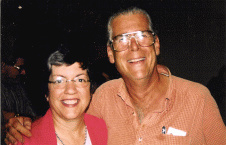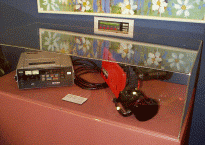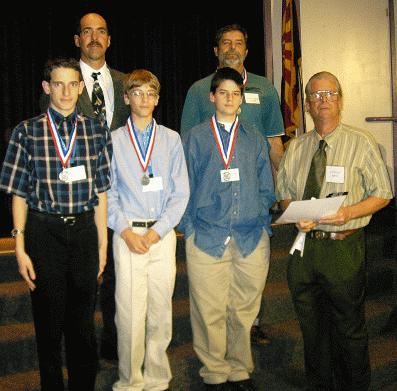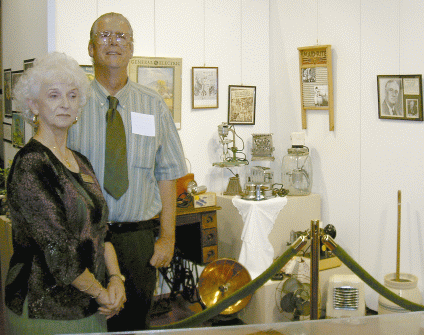|
These are a sample of a few projects |
||
|
Dedication
Ceremony Present: From St. Peter's- Jim Chalker, Gay Romack & Melissa Thomas From The Southwest Museum of Engineering Communications and Computation - Ed Sharpe SMECC donated over 155 Large Crates of books to fill the library. |
||
| As in years past, 2003 was not exception, thousands of books were gathered and transferred to the ReadFest held at Glendale Community College. Every Child that attended received a book as a gift and there were thousands of books for people to buy. The proceeds from this sale benefited the ReadFest group. | ||
| SMECC provided the bulk of the books for the Heard Museum book sale Jan 2004. we went by the sale and it was interesting to see people enjoying the treasures they were getting there! We have provided material for the last 3 yearly sales. | ||
|
2004 Futures City Competition
SMECC sponsored the award for
|
||
|
|
||
|
SMECC UPDATE - Ed Sharpe Director and Lead
Archivist for SMECC Historic Sahuaro Ranch, in Glendale Arizona, offers the highlight of the 2004-2005 season with the historical exhibit, "Rural Electrification." The Southwest Museum of Engineering, Communications and Computation (SMECC), located in Glendale Arizona, is proud to collaborate on this display by providing information, pictures, signs and example of appliances from the pre-electric and electrified era. SMECC Director, Ed Sharpe's interest in REA stemmed from a personal interest to learn about one of FDR's three letter programs whose coverage was lacking during his high school American history class. He wanted to learn as much as he could! "We had a small high density display of artifacts at the museum" Sharpe said. "We saw this exhibition as a dynamic example of two museums partnering to produce a large display with great depth" He continues, " Kudos to Carole De Cosmo at Historic Sahuaro Ranch Museum and her crew, the presentation of their material and our material was blended together in an intellectual and artistic manner." When asked why a display on REA, Sharpe replied, " You can learn about power distribution in cities from any of the major power producers." He continued "This was a chance to expose city folks to their rural cousin's quest for electrification and betterment of life, while providing visitors from outside the city a chance to reminisce about their gaining of power and technology." Sharpe continues to acquire more books, artifacts and paperwork related to REA, and also things related to all forms of engineering, communications and computation. This informative and entertaining exhibit tells how electricity dramatically changed the methods of farming and "Rural Electrification" explains who was responsible for bringing electrical power, what circumstances made it possible and feasible, when it happened, and how electric power was generated and transmitted in the past. The fact that the Salt River Valley was electrified before the REA and the rest of rural America is unknown to most Valley residents. The farmers mortgaged their land to bring water (and its byproduct, electricity) to the Valley. This display offers an education on Arizona history and also a look at what was happening in other farming communities in the United States through Rural Electric Cooperatives. Electricity made the farm family's live a more pleasant existence with the most profound effect on the farm wife. Before electricity the farm wife had to pump the water by hand, heat with coal and wood, wash all the clothes on a scrub board and tub, air dry the clothes and then iron them with irons heated by coal or wood stoves. After an exhausting day of all this and other work the poor lady would then read by the substandard light provided by candlelight or kerosene lamp. The rest of the family that was out working the operational aspects of the farm enjoyed the labor and time saving benefits offered by electricity. Milking the cows was faster and more efficient. Pumping water electrically was a wonder! Having good lighting added to productivity and safety. Electric tools made construction and repair on the farm move at a faster pace! Radios and later televisions could be just plugged into the wall.. gone were the bulky batteries and wind chargers. But... to learn all the benefits, you need to take in this wonderful exhibition! Rural Electrification brought farm families together as they formed cooperatives to obtain electric power. Some of the side activities included REA cook books, picnics, work parties, pot lucks and more. REA brought people together and made life better! Below: Rural Electrification Exhibit opening night. Carole De Cosmo, Director of Historic Sahuaro Ranch Museum and Ed Sharpe Director and Lead Archivist of SMECC. Pictured are some of the 3 dimensional and pictorial REA artifacts the SMECC lent for the exhibition.
|
||
 Governor
Janet Napolitano of Arizona and Ed Sharpe Director and Lead Archivist for
SMECC at Bitzee Mama's Restaurant in downtown Glendale Arizona. I
was fortunate to have some time to discuss science, technology
and education with Janet at the breakfast table. Unknown to many, Janet
coded in FORTRAN at Sandia High School in Albuquerque New Mexico in
her younger days! Governor
Janet Napolitano of Arizona and Ed Sharpe Director and Lead Archivist for
SMECC at Bitzee Mama's Restaurant in downtown Glendale Arizona. I
was fortunate to have some time to discuss science, technology
and education with Janet at the breakfast table. Unknown to many, Janet
coded in FORTRAN at Sandia High School in Albuquerque New Mexico in
her younger days!
|
||
 PHX11 ,
the Phoenix government cable channel, required a JVC KY2000 and a
3/4 JVC U-matic portable recorder to portray the first equipment they used
to put City of Phoenix government activities on cable television
PHX11 ,
the Phoenix government cable channel, required a JVC KY2000 and a
3/4 JVC U-matic portable recorder to portray the first equipment they used
to put City of Phoenix government activities on cable television
SMECC was able to assist them with the loan of equipment that is now on
display in the station lobby. PHX11 began in 1984 as the city of Phoenix's government access cable channel with a staff of four and five minutes of programming per week. Today, the award-winning PHX11 is one of the top local cable stations in the country, reaching an estimated 320,000 households throughout the Valley. It provides quality programs that educate, inform and entertain residents 24 hours a day, 7 days a week. |
||
|
Oct 1 -Mar 27
2005 RE
Az - The Electrification of the Salt River Valley. Located at Historic Sahuaro Ranch in the Fruit Packing Shed Gallery located at 9802 N. 59th Avenue. For more information call (623) 930-4500
SMECC will provide artifacts for this display! |
||


